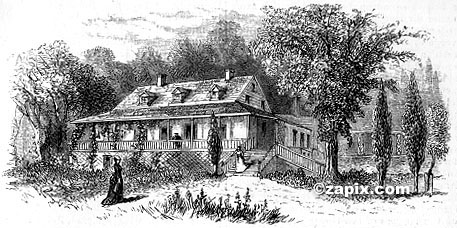|
|
The Romance of the Hudson, Part I, continued
 The Van Cortlandt Manor-House.
Up the narrowing bay at the east, below Croton Point, and beyond the line of the Hudson River Railway, may be seen, near its head, a quaint old mansion. The water, once deep, now rapidly changing into salt meadow land, is Croton Bay, in which Henry Hudson anchored his little exploring vessel. The mansion is the Van Cortlandt Manor-house, one of the most ancient and interesting in its associations of its class on the Hudson. Recent discoveries, while repairing it, of loop-holes for musketry near the floor, in the dining-room clearly show that it originally composed a fort, which was probably built by Governor Dongan soon after he purchased the domain, almost two hundred years ago. John Van Cortlandt enlarged it to its present dimensions in the early years of Queen Anne's reign, and from that period until now its broad roof has been accustomed to shelter men of renown in almost every sphere in life. Washington, Franklin, Schuyler, Lafayette, Whitefield, Asbury, and others have been entertained there. Its owners were men of note in the colony. At the time of the Revolution, and afterward, the head of the family (Pierre) was an eminent civilian, and his son was a patriotic soldier. Descendants occupy the mansion sanctified by age and generous deeds. History and romance tell of stirring scenes at time Van Cortlandt Manor-house. The record of one must suffice. Governor Tryon attempted to seduce the lord of the manor into the ranks of the royalists when the war for independence was kindling. Within his charming wife and the accomplished Miss Watts and his courteous secretary, Fanning, Tryon went to the manor-house, and initiated that honors and more broad acres awaited the master when he should espouse the cause of the king. The "Get thee behind me, Satan," reply, courteously given to the tempter, made Tryon say to Fanning, "Come, we'll return; I find nothing can be effected here." Over the main entrance to the manor-house hangs the strong bow of Croton, the sachem whose name has been given to the Kitchewan river and bay; and within the mansion are interesting mementos of the country from which and the family from whom the Van Cortlandts came — the Dukes of Courland, in Russia. Among its minor claims to respect and veneration is its possession of an invisible ghost, which, like a stately dame or charming belle, rustles its rich silk garments as it passes through a certain room at the midnight hour. Nature holds the key to the mystery, and persists in refusing to unlock the secret; nor will she reveal the origin of the sound of heavy footsteps in the great hall sometimes heard in the silent watches of the night. The mansion haunted in the day by the most gentle spirits. Passing Croton Point, the boat goes into the broad expanse of Haverstraw Bay, whose waters and shores form an amphitheatre in which stirring events have occurred. Here, at the sunsetting of a bright, crisp November day in the year 1825, was read with wondering eyes a chapter of one of the most thrilling of the romances of the Hudson. It was the brilliant nuptial procession at marriage of Neptune with the naiads of the forest. Gayly decked steamboats, sloops, canal-boats, and other vessels — a right royal fleet — were bearing the Governor of the State and other notables, with water from Lake Erie to be cast into the Atlantic Ocean, in commemoration of the completion of the Erie Canal, which wedded the great lakes to the Hudson River and the sea. It was a triumphal procession after a glorious victory won by the arts of peace. Almost fifty years before this, a flotilla of a different character and for a different purpose was seen on Haverstraw Bay. It was |
|
Page 13
Books & articles appearing here are modified adaptations
from a private collection of vintage books & magazines. Reproduction of these pages is prohibited without written permission. © Laurel O'Donnell, 1996-2006.
|
|

